#Forlinx Embedded
Explore tagged Tumblr posts
Text
#Forlinx Embedded#embeddedsolutions#electronica#SoMs#Rockchip#AI#IoT.#powerelectronics#powermanagement#powersemiconductor
0 notes
Text
Forlinx Embedded AM62x SoM, Empowering a New Generation of HMI
HMI (Human-Machine Interface) is a medium for interaction and information exchange between systems and users. It is essential in fields involving human-machine communication, and can be seen in many industries. As technology advances, HMI continues to evolve. In addition to data collection, control, and display, future HMI will incorporate new interactive forms to enable machines to operate more intelligently and interact more efficiently with humans.
The increasing demand for more intelligent human-machine interactions also raises higher requirements for processors used in HMI applications. In order to assist engineers with terminal development requirements in selecting the main controller, in this article, the author will provide a detailed explanation of the three key elements that will influence the next generation of HMI.
Smarter Interaction
AI support will help the new generation of HMI achieve more powerful functions. For example, AI face recognition can be used to realize human access to devices, and AI gesture recognition can also be used to realize contactless control between people and devices. At the same time, it also allows the equipment to monitor and analyze the current system status more accurately. For example, in the medical field, intelligent HMI systems can allow doctors to interact with medical devices through gestures.

Balance of Power Consumption And Performance
AI function support puts forward higher requirements for the performance of processors, and the high integration and performance improvement of chips will inevitably increase power consumption and generate more heat. In order for devices with limited size to be able to adapt to a more diverse and complex environment, it is very important to have multiple power consumption mode options - the freedom to choose between high power consumption, low power consumption, and ultra-low power consumption modes. This not only allows performance to be properly optimized, but also helps to better control costs, achieving a balance between power consumption and performance.
Enhanced Communication Capabilities
The increase in real-time industrial communication protocols has also brought new challenges to the new generation of HMI applications. For example, the HMI applied in the smart factory not only needs to carry the task of exchanging information between people and equipment, but also needs to complete the function of communicating with other machines and equipments, which means that the HMI needs to have a stronger connection and control function.

FET6254-C SoM launched by Forlinx Embedded not only meets the traditional HMI's human-computer interaction needs but also can realize the three key elements mentioned above, empowering the new generation of HMI.
FET6254-C System on module is built on the TI Sitara™ AM6254 industrial-grade processor, featuring a quad-core Arm Cortex-A53 architecture with a maximum frequency of up to 1.4GHz. It enables edge AI capabilities, making the HMI smarter and more intelligent. During the development process, rigorous environmental temperature testing, pressure testing, and long-term stability testing were conducted to ensure that it can operate stably in harsh environments.
Not only the performance is guaranteed, but also the power consumption can be very low. Through a simplified power architecture design, the AM62x processor exhibits extremely low power consumption performance, with power as low as 5mW in deep sleep mode. With a core voltage of 0.75V, the operating power can be kept below 1.5W, greatly reducing system power consumption.
AM62x processor, as the next-generation MPU product in the TI Sitara™ product line, offers richer resource interfaces compared to the previous generation classic processor, the AM335x. It includes features such as 2 x Gigabit Ethernet with TSN support, 3 x CAN-FD, 9 x UART, 2 x USB 2.0 , 2 x LVDS interfaces, RGB, camera, audio, and more. This enhances the product's scalability and flexibility for various applications.
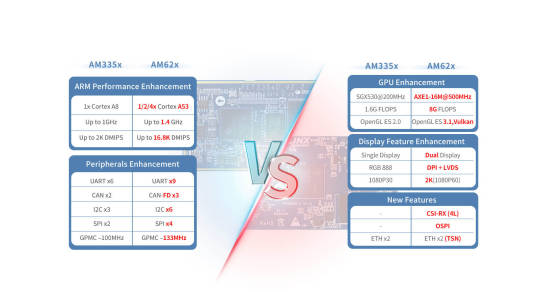
In addition to the advantages mentioned above, Forlinx Embedded has also ported a Chinese input method for the Linux system on the FET6254-C SoM. This makes it more convenient to invoke applications and helps users simplify their development workload. Moreover, the FET6254-C embedded board supports system burning via USB flash drive or TF card and can replace Uboot, Kernel, and device tree in the operating system, making it easy to achieve remote updates for products and helping users save on-site maintenance costs.
The combination of stable quality and rich functionality allows Forlinx Embedded's FET6254-C core board to demonstrate unique advantages in next-generation HMI applications, empowering HMI across industries such as industrial control, power, transportation, and healthcare. This enables machines to operate more intelligently and interact more efficiently with humans. The above is the HMI solution recommendation based on the Forlinx Embedded FET6254-C SoM. We hope it can be helpful for your product design.
Originally published at www.forlinx.net.
#HMI#Human Machine Interface#AI support#processor performance#communication capabilities#Forlinx Embedded
0 notes
Text
Linux-driven i.MX6 gateway offers 4G plus isolated serial and CANBus
Linux-driven i.MX6 gateway offers 4G plus isolated serial and CANBus
[ad_1]
Forlinx announced a compact “FCU1201” IoT gateway that runs Linux on an i.MX6 DualLite and offers 4G, WiFi/BT, LAN, CAN, HDMI, USB, serial, DIDO, and CANBus. Chinese embedded vendor Forlinx has unveiled a power-efficient FCU1201 IoT gateway equipped with NXP’s 1GHz, dual-core Cortex-A9 i.MX6 DualLite. Like the company’s i.MX6 UL-equipped FCU1101, the system combines extensive serial…
View On WordPress
0 notes
Text
Display and Modification of LVDS Display Interface on AM62x Development Board

1. LVDS Interface Specification
Forlinx Embedded OK6254-C development board provides 2 x 4-lane LVDS display serial interfaces supporting up to 1.19Gbps per lane; the maximum resolution supported by a single LVDS interface is WUXGA (1920 x 1200@60fps, 162MHz pixel clock).
In addition, the interface supports the following three output modes:
(1) Single-channel LVDS output mode: at this time, only 1 x LVDS interface displays output;
(2) 2x single-channel LVDS (copy) output mode: in this mode, 2 x LVDS display and output the same content;
(3) Dual LVDS output mode: 8-lane data and 2-lane clock form the same display output channel.Forlinx Embedded OK6254-C development board is equipped with dual asynchronous channels (8 data, 2 clocks), supporting 1920x1200@60fps. All signals are by default compatible with Forlinx Embedded's 10.1-inch LVDS screen, with a resolution of 1280x800@60fps.
2. Output Mode Setting
(1) Single LVDS output mode:
We need a single LVDS screen cable. The black port of the cable is connected to the embedded OK6254-C development board, and the white port is connected to the embedded 10.1-inch LVDS display screen. Connection method as shown in the figure below:
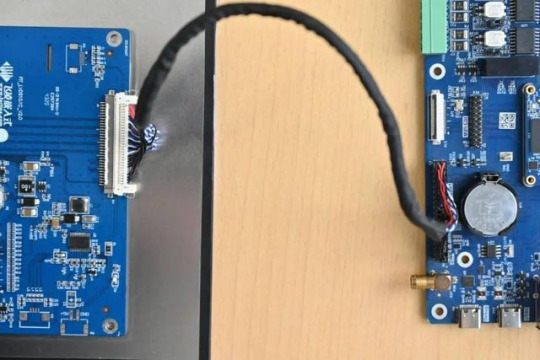
Note that the red line section corresponds to the triangle position, so don't plug it in wrong.
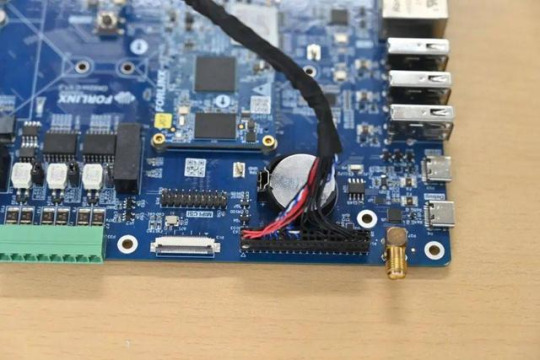
(2) 2x single LVDS (duplicate) output mode:
This mode uses the same connections as the Single LVDS Output Mode. Two white ports link to two 10.1-inch LVDS screens from Forlinx Embedded, and a black port on the right connects to the OK6254-C board's LVDS interface for dual-screen display.
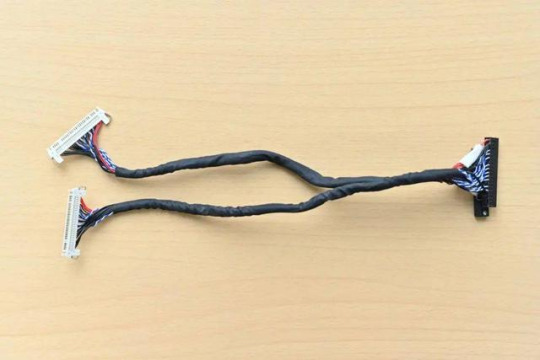
(3) Dual LVDS output mode:
The maximum resolution supported by a single LVDS interface on the OK6254-C development board is WUXGA (1920 x 1200@60fps). To achieve this high-resolution display output, dual LVDS output mode is required.
It is worth noting that the connection between the development board and the screen in this mode is the same as in [Single LVDS Output Mode], but the LVDS cable's and the screen's specifications have been improved.
3. Screen Resolution Changing Method
OK6254-C development board device tree is easy to modify, we need to open the OK6254-C-lvds.dts (single 8-way configuration) and OK6254-C-lvds-dual.dts (dual 8-way configuration) files.
Open OK6254-C-lvds.dts
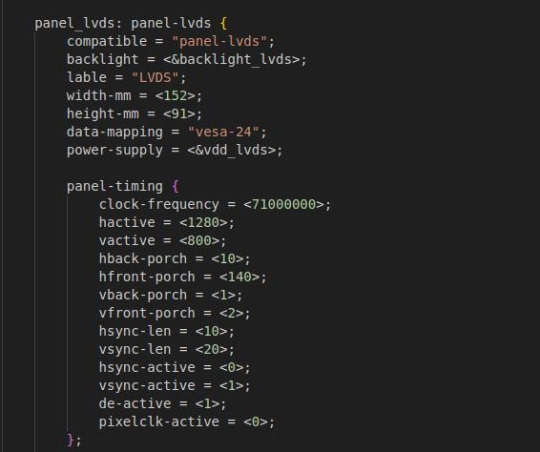
Open OK6254-C-lvds-dual.dts
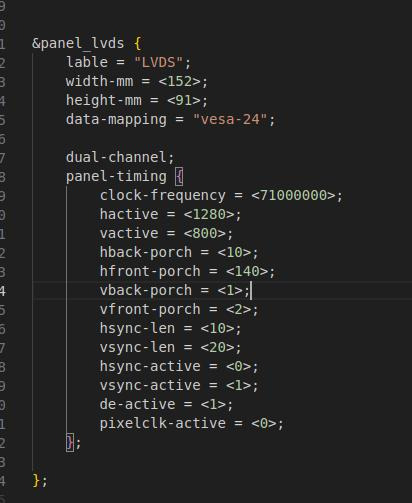
The above figure is the single LVDS and dual LVDS screen resolution information, the default resolution of 1024 * 600, and the maximum resolution support of 1920x1200, you can modify the corresponding parameters according to the Screen User’s Manual.
4. Compilation Configuration
Because we only modified the device tree, we don't need a full compilation. After compiling the kernel, a new Image and multiple device tree files will be generated in the images directory. Here we only need to compile the kernel separately.
(1) Switch directory: cd OK6254-linux-sdk/
(2) Execution environment variables:.. build.sh
(3) Execute the instructions that compile the kernel separately: sudo./build. Sh kernel.
(4) Pack all the device tree files to the development board /boot/ directory and replace them, then sync save and reboot scp images/OK6254-C* [email protected]:/boot/
We have modified the corresponding file. How should we select the screen after replacing it? At present, there are three kinds of screen switching control methods: kernel device tree designation, Uboot menu dynamic control, Forlinx Desktop interface and Uboot menu application. Today, I will briefly introduce the dynamic control of Uboot menu.
During Uboot, pressing the space bar will take you to the Uboot menu. There are three options in the menu:
Enter 0 to enter the Uboot command line;
Enter 1 to restart Uboot;
Enter 2 to enter the Display Configuration menu.

There are three options in the menu:
Enter 0 to return to the previous menu;
Enter 1 will toggle what option 1 displays to configure Screen 1 LVDS; Note: Screen 1 supports single LVDS, dual LVDS, and off (i.e., LVDS off)
Enter 2 to toggle the display of option 2 to configure the Screen 2 LCD. Note: Screen 2 supports 1024 * 600 resolution LCD screen, 800 * 480 resolution LCD screen and off (i.e. RGB off)
When selecting the LVDS screen, we enter 1 to select single 8-channel LVDS or dual 8-channel LVDS.

After selecting the desired configuration, enter 0 to return to the previous menu level. Restart Uboot or enter the command line to start the system, which can make the screen settings take effect. For other resolution screens, please modify the kernel device tree screen parameters according to the screen parameter requirements.
Originally published at www.forlinx.net.
#LVDS Interface#Forlinx Embedded#OK6254C#Screen Resolution Changing Method#Compilation Configuration#Uboot menu dynamic control
0 notes
Text
Introduction of Forlinx Embedded's Upcoming SoM Based on RISC-V Architecture
In recent years, RISC-V has attracted a lot of attention because of its completely open source, free of charge, and free to modify without constraints. Under this background, Forlinx Embedded works together with a RISC-V processor manufacturer and launches FET7110-C SoM based on Jinghong(JH) 7110 processor!

The FET-JH7110-C SoM is designed and developed based on the JH7110 processor, with a process of 28 nm, open source RISC-V architecture, main frequency of 1.5 GHz, and integrated 4-core U74 architecture; It has powerful GPU processing capability and supports multi-lane video encoding and decoding, common functional interfaces such as 2xPCIe 2.0, 2xGigabit Ethernet, 2xCAN 2.0, etc. The SoM supports Linux 5.15.0 suitable for industrial vision-related application development.
In the future, Forlinx Embedded will take an active and open attitude in continuing to cooperate with more chip manufacturers and provide customers with more stable, reliable, and comprehensive intelligent control products!
Other Recommended Articles:
Originally published at www.forlinx.net.
0 notes
Text
Big news! DeepSeek-R1, the powerful AI large language model, has been deployed on the Forlinx OK3588-C dev board. The process: download code, install tools, convert model, compile & deploy. Now, have offline chats!
DeepSeek-R1 can search info, give equipment advice, solve math & code!
Performance? Impressive! Low CPU usage (12-17%), 825MB memory, 83% NPU load.
Stay tuned for more details. Forlinx Embedded offers support. Let's innovate!

1 note
·
View note
Text
Forlinx Embedded FETMX8MM-C SoM now supports the Linux 6.1 system. This upgrade not only enriches the system’s function but also significantly enhances memory performance through a new BSP (Board Support Package).

Based on the NXP i.MX8M Mini processor, Forlinx Embedded FETMX8MM-C SoM features 4 x high-performance Cortex-A53 cores and 1 x real-time Cortex-M4 core, delivering high performance, computational power, and a smooth system operation speed. Linux 6.1 system introduces several new features, including enhanced hardware acceleration, optimized power management, and improved system security and stability. These enhancements make the FETMX8MM-C SoM perform exceptionally well in data processing, power consumption control, and data security.
FETMX8MM-C platform has various built-in command line tools available to users, As follows:root@okmx8mm:~# uname -a Linux okmx8mm 6.1.36 #19 SMP PREEMPT Wed Oct 9 18:15:14 CST 2024 aarch64 GNU/Linux
The highlight of this upgrade is the significant boost in memory bandwidth. Thanks to the new BSP, the FETMX8MM-C’s memory read bandwidth has surged to approximately 2170 MB/s, while the write bandwidth has reached about 1030 MB/s—almost doubling compared to previous versions.
This means that when handling large data sets, high-definition video, or complex algorithms, the SoM can provide smoother and more efficient performance, significantly enhancing the user experience.
Addtionally, the FETMX8MM-C SoM is equipped with a rich set of peripheral interfaces, such as MIPI-CSI, MIPI-DSI, USB, and PCIe, offering users great flexibility for expansion.
It is worth noting that the i.MX8M Mini processor on the FETMX8MM-C SoM benefits from NXP’s long-term supply commitment, ensuring at least 15 years of stable supply, providing users with reliable assurance for long-term usage.
In summary, with the support of the Linux 6.1 system, the Forlinx Embedded FETMX8MM-C SoM not only sees a substantial increase in memory bandwidth but also gains more comprehensive system functionality, making it an ideal choice for high-performance embedded application development.
0 notes
Text
Forlinx Launches a Development Board Based on RK3568 Chipset with Debian 11 Version
On November 7th, 2023, Forlinx Embedded launched the Debian 11 system for the first time on their development board, OK3568-C/OK3568J-C, which is based on the RK3568 chipset.
Forlinx Embedded officially supports the Debian 11 system on the OK3568-C/OK3568J-C platform. In the field of embedded development, stability and richness are crucial factors.

The RK3568, Forlinx's flagship embedded product, has high performance, low power consumption, and rich interface functions, making it appreciated by industry users.
Debian 11 is a stable, reliable, and open-source operating system, which provides a powerful foundation for the OK3568-C. Debian 11 has undergone rigorous testing and validation to ensure system stability, so there is no need to worry about unexpected crashes or data loss.
Moreover, Debian 11 has a vast software library, which enables developers to easily install and update required software packages.
By combining the advantages of the OK3568-C hardware with Debian 11, developers can fully leverage the diversity of the 3568 hardware interfaces while enjoying the stability and open-source nature of Debian 11. Indeed, this strong combination provides an ideal environment for various embedded projects.
When it comes to stability, free and open source, versatility, and vast software libraries, no operating system can rival Debian. Debian is a truly free operating system, and its strength is not only reflected in technology, but also in its active community.
Stable Value: Debian stands out for its world-renowned stability. Whether you are building critical business systems or looking for reliable daily desktops, Debian is always the best choice. Debian 11 has undergone rigorous testing and validation to ensure system stability, so there is no need to worry about unexpected crashes or data loss.
Free and Open Source: Debian adheres to the concept of free and open source, allowing you to freely use, modify, and share it. This is a truly free operating system. Not only can Debian be obtained for free, but you can also freely view, edit, and distribute its source code.
Huge Software Library: Debian has a vast and diverse software library that covers almost any application and tool you can imagine. From office software to entertainment applications, server services to programming tools, Debian has everything in its software library. Not only that, it also provides an easy-to-use package management system, allowing you to easily install and update software.
Multi-architecture Support: Debian supports multiple hardware architectures, including x86, ARM, PowerPC, MIPS, etc., making it suitable for various devices and systems. Whether you use a desktop, laptop, server, or embedded device, Debian can provide the ideal solution.
Active Community Support: The Debian community is a vibrant place where you can find help, advice, and resources. Both novice and experienced users can participate in the community and receive support.
Originally published at www.forlinx.net.
0 notes
Text
Forlinx Officially Launches RISC-V SoM Based on StarFive JH7110!
Forlinx has officially launched their latest System-on-Module, featuring the powerful StarFive JH7110 RISC-V chip. These versatile SoM and compatible carrier board are now available for order, catering to a wide range of applications including commercial, medical, and industrial automation.
Recently, a few embedded products have emerged utilizing the same processor, including the VisionFive 2, Pine64, and Milk-V Mars. However, the FET7110 SoM will be the first product from Forlinx to feature the integrated Jinghong 7110 processor. See the JH7110 block diagram for reference.
• JH7110 – 64-bit RISC-V, up to 1.5GHz (quad SiFive U74-RV64GC, up to 5.09 CoreMark/MHz)

JH7110 block diagram
The JH7110’s GPU integrates the IMG BXE-4-32 MC1 (up to 600MHz) which offers full support for mainstream APIs like OpenCL 3.0, OpenGL ES 3.2, and Vulkan 1.2.

Regarding power consumption, Forlinx indicates that the JH7110 is segmented into eight independently switchable power domains. Additionally, the CPU frequency can be dynamically adjusted via software, allowing customers to fine-tune the frequency based on various application scenarios that require flexible control and power consumption.

The JH7110 facilitates camera access through both MIPI-CSI and DVP interfaces, with ISP support. It enables video decoding capabilities of up to 4K@60fps and video encoding of 1080p@30fps. Moreover, the SoM supports HDMI (4K@30fps) and RGB (1080p@30fps) display output interfaces, along with MIPI-DSI (2K@30fps).

Specifications listed for the FET7110-C SoM include:
• Memory/Storage:
○ 2/4GB LPDDR4 RAM
○ 32GB eMMC 5.0
○ 100 Mbps QSPI
○ SD 3.0/MMC 5.0
• Connectivity:
○ 2x GMAC for RMII/RGMII 10/100/1000 Mbps
• Display/Audio:
○ 1x HDMI 2.0 (up to 4K@30fps)
○ 1x 4-lane MIPI DSI, (up to 2K@30fps)
○ 8-lane I2S PCM/TDM
• Camera:
○ 1x 4-lane MIPI-CSI
• Expansion:
○ 1x PCIe2.0x1, 2 PCIe2.0 controllers integrated w/ PHY
• USB:
○ 1x USB 2.0
○ 1x USB 3.0
• I/O Peripherals:
○ 6x UART, 7x I2C, 7x SPI
○ 1x SDIO
○ 8x PWM
○ 64x GPIOs
○ 2x CAN 2.0B (Up to 5Mbps)
• Power:
○ 5V DC
• OS:
○ Linux 5.15.0
• Mechanical:
○ 60 x 38mm
○ B2B connectors (3x 80-pin)
Specifications listed for the OK7110-C development board include:
• Memory/Storage:
○ 2/4GB LPDDR4 RAM
○ 32GB eMMC 5.0
○ 100 Mbps QSPI
○ SD 3.0/MMC 5.0
• Connectivity:
○ 2x Gigabit Ethernet ports
• Display/Audio:
○ 1x HDMI 2.0 port
○ 1x MIPI DSI
○ 2x Speakers
○ 1x Mic
• Camera:
○ 1x MIPI-CSI
• Expansion:
○ 2x PCIE 2.0
○ 1x Micro SIM
• USB:
○ 1x USB Type-C
○ 3x USB 3.0
• I/O Peripherals:
○ 2x CAN
○ 2x RS485
• Other Features:
○ 1x Power button, 1x Reset key
○ RTC battery
• Power:
○ 12V DC (via barrel connector)
• Mechanical
○ B2B connectors (3x 80-pin)
These products are now available for ordering. Customers can find the product page for the FET7110-C SoM here.
0 notes
Text
Setting up network services on your Forlinx OK-MX9352-C Linux platform just got easier!

Learn how to quickly configure TFTP, NFS, and SSH services to streamline your embedded development workflow.
From installation to testing, this step-by-step guide covers everything you need to connect, transfer files, and remotely manage your device efficiently.
Whether you’re using Linux 6.1.36 or a similar environment, this tutorial is your go-to reference.
0 notes
Text
Driving Smarter Microgrids with Forlinx Embedded!
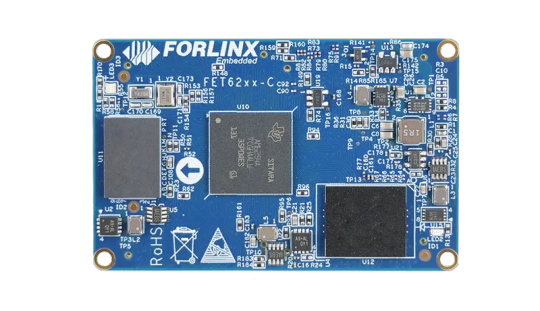
To support global carbon neutrality goals, microgrids are becoming a vital piece of the energy puzzle. The Forlinx AM62x-based FET6254-C SoM is revolutionizing microgrid coordination with:
⚡ Multi-core architecture (Cortex-A53 + Cortex-M4F) 🔄 Millisecond-level real-time control 🔌 Rich interfaces: CAN-FD, UART, TSN Ethernet 🌡️ Industrial-grade design: -40°C to +85°C

Perfect for PV, wind, storage & EV charging station coordination.
0 notes
Text
🚨 Prevent Electrical Fires Before They Start Did you know that up to 70% of electrical fires are preventable?
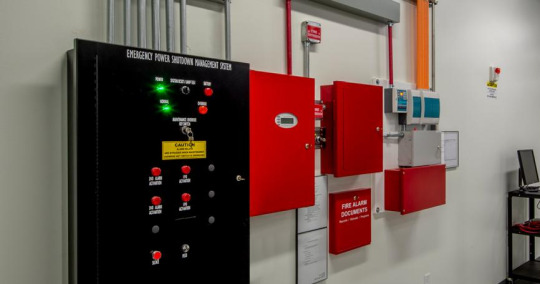
Forlinx Embedded presents a smart and efficient solution for electrical fire monitoring systems powered by the FET6254-C SoM.
With real-time monitoring, fast alerts, dual-core architecture, and industrial-grade stability, this solution is ideal for residential, commercial, and industrial applications.
✅ Real-time current, voltage & temperature monitoring ✅ Reliable alerts on overheating, short circuits & more ✅ Dual-core (A-core + M-core) for mission-critical stability ✅ Rich interfaces: CAN-FD, UART, Gigabit Ethernet, LVDS ✅ Designed for industrial environments

#Forlinx#EmbeddedSystems#ElectricalSafety#FirePrevention#IoT#SmartMonitoring#FET6254C#IndustrialControl
0 notes
Text
Having trouble with your Forlinx AM62x development board?
Our latest troubleshooting guide covers common interface issues including power checks, I2C & SPI communication, USB & SDIO signal integrity, and more!

Get practical tips to quickly diagnose and fix boot failures and interface glitches.
Perfect for embedded developers working with OK62xx-C boards.
Stay tuned for Phase 2 with UART, CAN, PCIe, and LVDS troubleshooting!
0 notes
Text
Are you working with the Allwinner T113 platform and need better real-time performance? This step-by-step guide walks you through applying the PREEMPT-RT patch to the Linux 5.4.61 kernel using the OK113i SDK.

🧩 What you'll learn:
How to download and apply the patch-5.4.61-rt37
How to resolve patch conflicts manually
How to configure and save .config properly
How to add rt-tests in Buildroot
How to test real-time latency with cyclictest
📉 Result:
With the RT patch, latency dropped from over 9 ms to just 60 µs—a huge improvement for real-time embedded applications.
📦 Perfect for industrial control, robotics, or any time-sensitive edge computing scenario using the T113.
0 notes
Text
Want to customize your embedded Linux system with Buildroot on the Forlinx OK3588-C platform?

This step-by-step guide walks you through compiling Buildroot 5.10.209, adding system tools like OpenCV4, and preparing a complete cross-compilation environment.
Perfect for embedded developers working with ARM64!
0 notes
Text
5-Minute Quick Guide: Set Up TFTP, NFS, and SSH on i.MX9352 with Linux 6.1

Want to speed up embedded development on the Forlinx OK-MX9352-C board?
Our step-by-step guide helps you quickly configure essential network services — TFTP for file transfer, NFS for rootfs sharing, and SSH for secure remote login.
💡 Perfect for industrial IoT and edge development scenarios!
0 notes